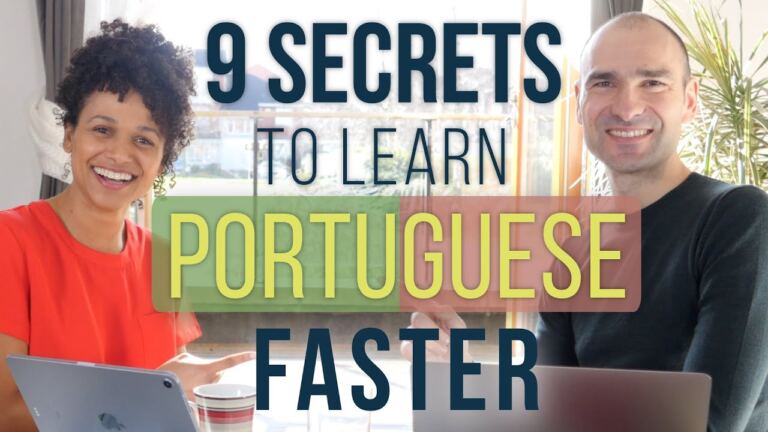10 Ways to Say Thank You in Portuguese
Learn 10 different ways to say thank you in European Portuguese!
In this video, learn 10 different ways to say thank you in European Portuguese. The most common way to say thank you in Portuguese is with the word Obrigado (masculine) or Obrigada (feminine). Along with greetings, like Bom dia (Good morning), and polite expressions, like Por favor (Please), these are two of the most basic Portuguese words.
Still, Portuguese people use many other terms to express gratitude in everyday conversations. Some are perfect for formal settings, while others are only for informal situations.
Watch the video to discover how to say thank you in Portuguese. Explore the equivalent English words to these everyday terms of the Portuguese language.
Muito obrigado/a (Thank you very much) – 10 Ways to Say Thank You in Portuguese
Here’s a list of the 10 ways to say thank you in Portuguese mentioned in the video:
- Muitíssimo obrigado/a (Thank you so very much)
- Obrigadíssimo/a (Thank you so much)
- Grato/a (Thankful)
- Quero agradecer por... ( I want to thank…)
- Obrigadão or its shortened version Brigadão (very informal way; the literal translation is Huge thanks)
- Obrigadinho/a (Thanks a lot)
- Obrigado por or Obrigada por… (Thank you for)
- Agradeço (I appreciate)
- Dar graças (Give thanks)
- Bem haja! (Cheers or God Bless)
In European Portuguese, the answer would be Não tem de quê or De nada (You’re welcome). In Brazilian Portuguese, the answer to these expressions is Não há de quê or Por nada. Check out the links below to learn more!
Extra content 💯
– The Portuguese With Carla Blog: https://portuguesewithcarla.com/blog/
– The Meaning of Obrigado – Saying Thank You in Portuguese: https://portuguesewithcarla.com/meaning-of-obrigado-thank-you-in-portuguese/
– How to say thank you in Portuguese – Obrigado or Obrigada? https://www.youtube.com/watch?v=12Z6941s1vY
Visit our website to learn more about The Journey: https://portuguesewithcarla.com/
Get more content through our social media! 🤩
Instagram: https://www.instagram.com/portuguesewithcarla/
Facebook: facebook.com/PortugueseWithCarla/
Spotify: https://open.spotify.com/playlist/3U1mbtskdFko6CrVDoW6m3?go=1&sp_cid=e6e1f1c912054f4f3a4d8d1ccf91bba1&utm_source=embed_player_p&utm_medium=desktop&nd=1&dlsi=be0a6f86eb0b47e9
Don’t forget to drop us a like, follow, and turn on your notifications 🔔 so you don’t miss a thing! 😎
Ready to become fluent in European Portuguese?
For the last decade, we’ve been working on putting together the best possible European Portuguese course. After much research, feedback from our students, and a number of iterations, we think we’ve got it! 😉
As a base, we used scientifically proven techniques to help with master pronunciation, phrase construction, oral understanding, grammar, and all the necessary bits to get you to fluency. At the same time, having learned foreign languages ourselves, we know the process needs to be engaging, varied, and enjoyable. The whole thing is presented as an adventure. It’s a course like no other, trust us!
Learn more about The Journey and start your free trial here.



![The history of the ORIGINAL Portuguese Custard Tart (Pastel de Nata) -Pastel de Belém [PT & EN subs]](https://portuguesewithcarla.com/wp-content/uploads/2020/06/The-history-of-the-ORIGINAL-Portuguese-Custard-Tart-Pastel-de-Nata-Pastel-de-Belem-PT-EN-subs-768x432.jpg)


![All the Types of Coffee served in Portugal [PT & EN subs]](https://portuguesewithcarla.com/wp-content/uploads/2022/02/All-the-Types-of-Coffee-served-in-Portugal-PT-EN-subs-768x432.jpg)
Oooh muito obrigado pelo vídeo!! Gosto muito de “obrigadíssimo” 😍💐
Eu é que agradeço 😊
Wow. So fast.
I would suggest that to start with you use the YouTube settings to slow it down a little and then listen to it again at the normal speed. But it’s important you get used to understanding a more normal pace of speaking from the native Portuguese speakers. In this video I speak quite slowly actually 😅 if I was to speak slower all the time and you were able to follow comfortably this would give you a false sense of accomplishment which likely leads to frustration when having to deal with real life situations in Portugal.
Muito obrigada, Carla! ❤ É util, como sempre! 😊
Disponha! 🤗
It would be great if you talked a little slower. I really want to learn but this was really to fast.
An easy fix; Click the settings symbol “⚙️” on the screen and change the playback speed.
Or just talk slower if you want to instruct people
@@jayke00 Your entitlement is showing. And, you’re just interested in complaining. Perhaps you should just stick to English. Like, the difference between to and too. Adeus.
@@jayke00Im sorry you feel this way. But in this video I did actually speak slower than most Portuguese speakers naturally do. It is true I’m instructing, and I understand why you think i should slow down even more so. But this speed is also part of our approach to teaching Portuguese – which we believe delivers better results with greater sense of accomplishment by the learners. When we slow down too much we enunciate every single syllable in a way we don’t normally do. This would possibly result in students feeling frustrated when experiencing real life situations and not understanding the natives. By speaking at a fairly normal to a slightly slower speed I allow myself to speak naturally. If you use the youtube settings to slow it down you’ll hear the natural speech in a slower way. Once you’re comfortable with that listen to it again at the normal pace and perhaps even challenge yourself to listening to it at a quicker speed. I hope this helps ☺️
I absolutely love this video! Don’t worry about the comments your talking at just the right pace for what the lesson is about!
Glad you liked it!! 😊
@@portuguesewithcarla as a native English speaker trying to learn Portuguese your content has been soooo helpful! Thank you Carla keep up the good work!
@@NeptuneDesign 🙏🏽🥰
🎉